Install the app
How to install the app on iOS
Follow along with the video below to see how to install our site as a web app on your home screen.
Note: This feature may not be available in some browsers.
You are using an out of date browser. It may not display this or other websites correctly.
You should upgrade or use an alternative browser.
You should upgrade or use an alternative browser.
Japan
- Thread starter connyxy
- Start date
Richarde57
Active member
Headlights?
Nose is complete different.
☼
Nose is complete different.
☼
reborn1928
New member

Test Joban Line Fujishiro To Sanuki

Test Joban Line Fujishiro To Sanuki
Belajar tod
reborn1928
New member
leonardericli
JR West 207 Series EMU
I'm trying to simulate basic japanese station operations, feel free to give some feedback.
Sorry for the bad quality, it was just an Operation simulation.
i want to ask something, did someone made a working Platform Doors? i hope someone made them with ATLS compatibility...
Sorry for the bad quality, it was just an Operation simulation.
i want to ask something, did someone made a working Platform Doors? i hope someone made them with ATLS compatibility...
Last edited:
Andi_Ridho_Ciputra
Content and Route Creator
My apologies
Hi guys. Long time no see. It's been more than a year since my last post. I really really apologize for the inconvenience and sorry for the very long delayed, because I lost my PC for a few months ago, but now I can buy a new PC, it will not happen again in the future. So here is the progress update for E3 Shinkansen (Pagroove's & aceelaamtrak's order). I'll do my best. I will send progress report at least once a week.


Hi guys. Long time no see. It's been more than a year since my last post. I really really apologize for the inconvenience and sorry for the very long delayed, because I lost my PC for a few months ago, but now I can buy a new PC, it will not happen again in the future. So here is the progress update for E3 Shinkansen (Pagroove's & aceelaamtrak's order). I'll do my best. I will send progress report at least once a week.


leonardericli
JR West 207 Series EMU
register your game
I already registered my game at the very beginning, yet it wont show up.
I even already had access to DLS, Unregistered games wont have any access to DLS right?
Weird? Yes it is.
Last edited:
Hi guys. Long time no see. It's been more than a year since my last post. I really really apologize for the inconvenience and sorry for the very long delayed, because I lost my PC for a few months ago, but now I can buy a new PC, it will not happen again in the future. So here is the progress update for E3 Shinkansen (Pagroove's & aceelaamtrak's order). I'll do my best. I will send progress report at least once a week.
Ah that's great news. Glad you are at it. I only want you to succeed. Both on Yamanote v2.0. and the E3 sets. But take your time now (I mean by that build in your own tempo) because it does take long now anyway :hehe:. But don't take a year again from here.
Railshuttle
Member
Nice Video there though it was kinda dark in some places. I know JR Freight doesn't get much attention or love but I was wondering would anyone consider making animated Jr contaier wagons that can be loaded and unloaded and a small animated container termainal for them?
A new reskin collection is here:
Volume 2: The EF64
The pack contains 8 reskins of the EF64 by Hirochi, plus three reskinned 14-series passenger cars, also by Hirochi
https://drive.google.com/open?id=1H6LbNdybE9bqkazCh1b-HECNXAUAnlku
[RC2-1] EF64-1000 in JR Freight's revised refurbished livery (Okayama Depot).
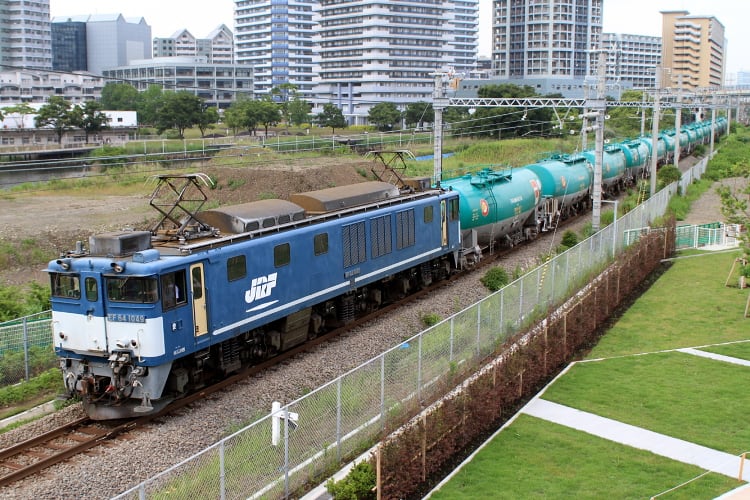
In 2003, JR Freight started refurbishing and upgrading it's EF64-1000s.
They initially recieved the light blue-white livery identical to the refurbished EF64-0s, but due to complaints from the maintainance staff about visually distinguish them from refurbished EF65-1000s, a new livery based on blue and white with diagonal lines and a red JRF logo (dubbed the "milk carton" by railway enthusiasts) was introduced on the units of Takasaki Depot.
Okayama Depot instead applied a simplified livery based on the original JNR standard blue of non-refurbished units, with white lower cab fronts, logos and side line, retaining only the mustard-colored cab doors of the original refurbished livery.

A "milk carton" livery of Takasaki Depot units.
This variant has already been made by Hirochi as the EF64 1009 avaible on the DLS
[RC2-2] EF64-0 JR Freight Original Refurbished Livery (Omiya Works Variant)
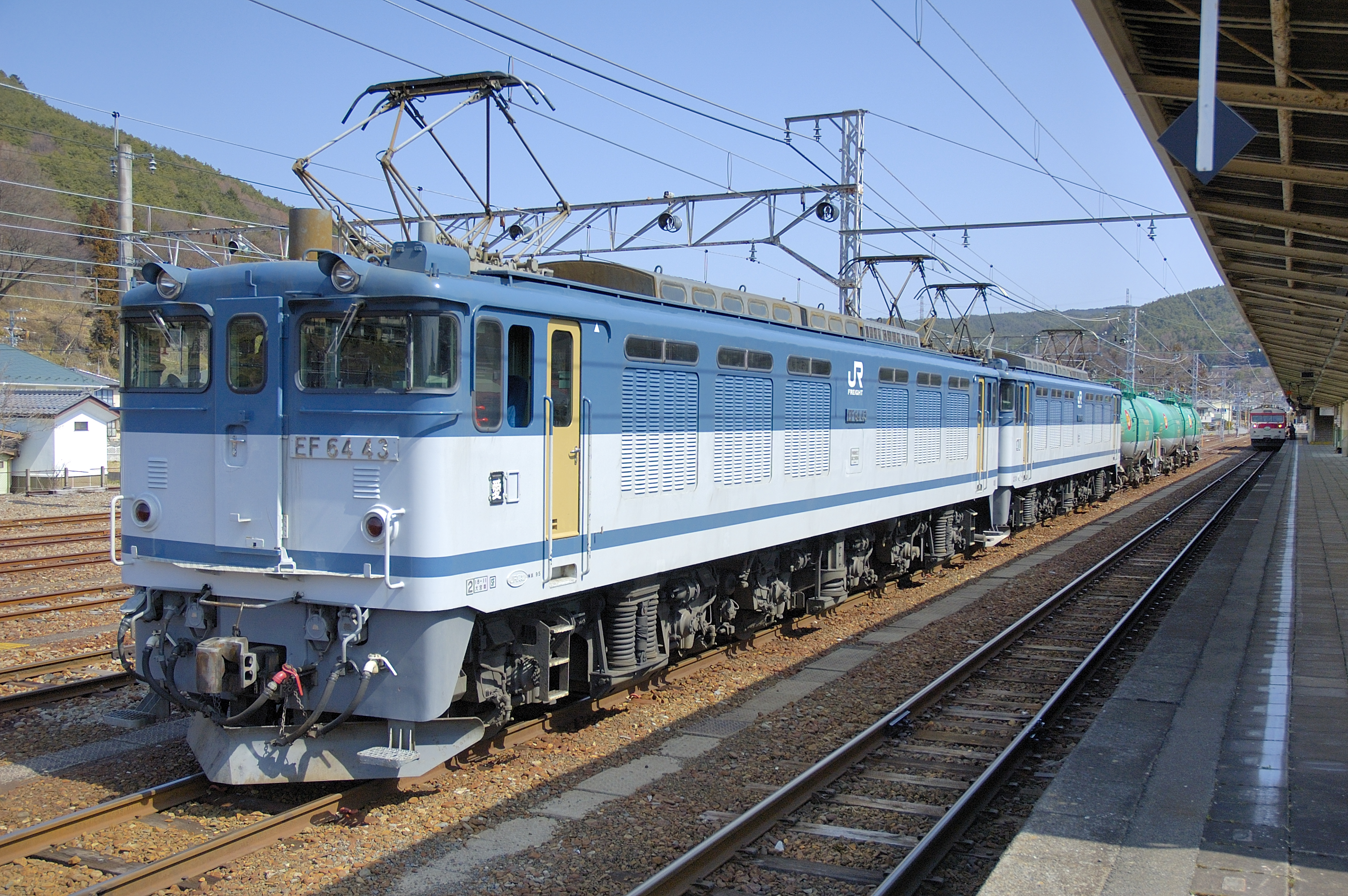
Applied starting from 1996 on JR Freight EF64-0s, with EF64 67 being the first unit refurbished.
Used on freight duties on the Chuo Main line (Tokyo to Nagoya via Takao, Shiojiri and Nakatsugawa).
[RC2-3] EF64-0 JR Freight Original Refurbished Livery (Hiroshima Works Variant)

Like their eastern counterpart, the EF64-0s of Okayama depot started to recieve the refurbished livery in 1996, but with a few variants, such as a mostard-coloured front door and number plate.
They are in service on mountain routes in western Japan, such as the Hakubi line.
[RC2-4] EF64 1001 in brown livery with a white line

This locomotive is owned by JR East and based at Takasaki depot. It's employed primarily on passenger train charter duties, in October 2017 it was repainted into it's original JNR blue livery.
[RC2-5] EF64 37 Brown livery with silver numbers
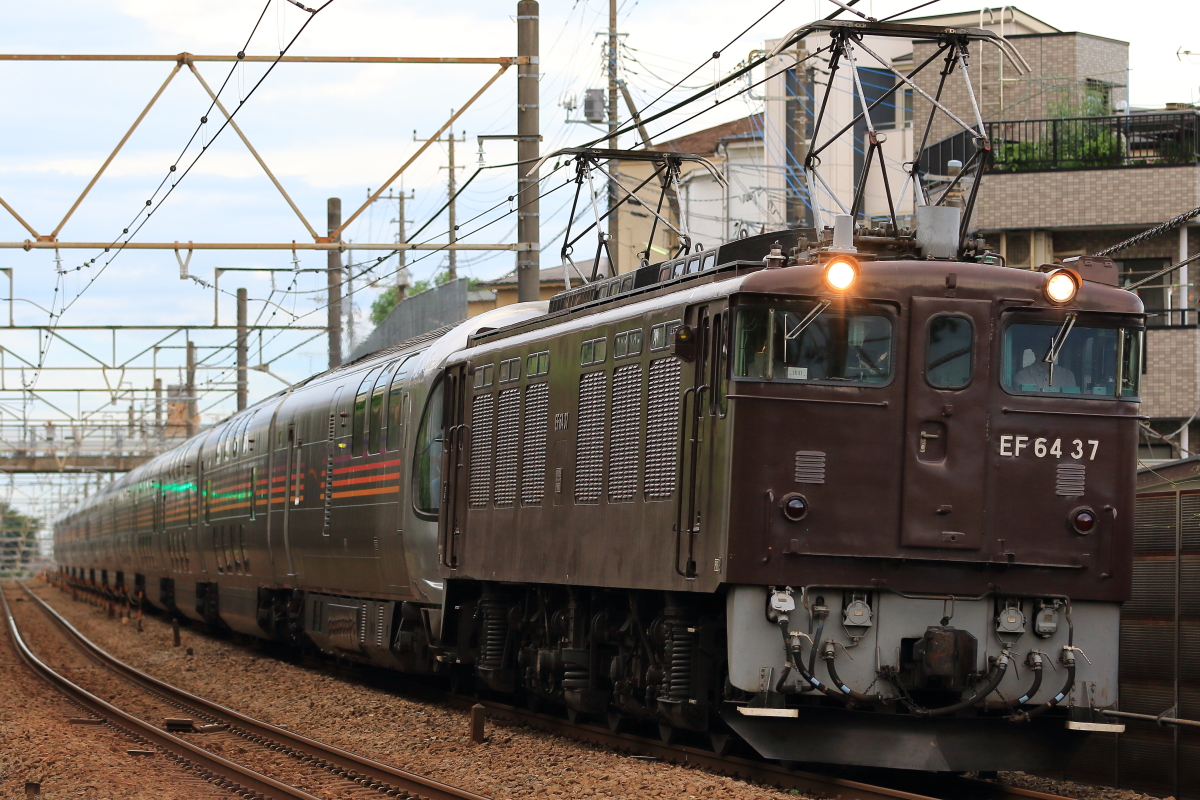
Repainted into an all-brown livery in 2003 to commemorate the 100th anniversary of the opening of the Chuo Main Line between Kofu and Enzan.
Registered at Takasaki depot, but normally based at Kofu, it's used on passenger charter services and sometimes also on work and maintainance trains.
[RC2-6] EF64 41 Brown livery with golden numbers

Repainted in May 2006 to a brown livery based on the EF64 37, but with golden numbers insead.
Like the EF64 37, it's used on passenger charter services and sometimes also on work and maintainance trains.
[RC2-7] EF64 35 Euroliner - JR Central Joyful Train

The Euroliner was a Joyful train operated by JR Central from 1987 to 2005.
Originally planned in the very last years of JNR, it was composed of 14-series coaches in a variable composition between 5 and 10 cars.
It ran on the Chuo Main Line, the Tokaido Line and the (non electrified) Ida line.
A few locos were designated to haul this train, namely EF64 35 and 66, EF65 105, 106 and 112 and DD51 791 and 1037, all fitted in a matching livery.
The Euroliner was the first example of an expres train with all-uniform livery shared between the locomotive and the coaches.
It was withdrawn in 2005 following a decrease in ridership. The carriages were scrapped and the locomotives retuned to their original colors, except a few (such as the EF64 35) that carried the white and blue color well into the 2010s, usually assigned to work trains or charter specials.
[RC2-8] EF71 series AC electric locomotive
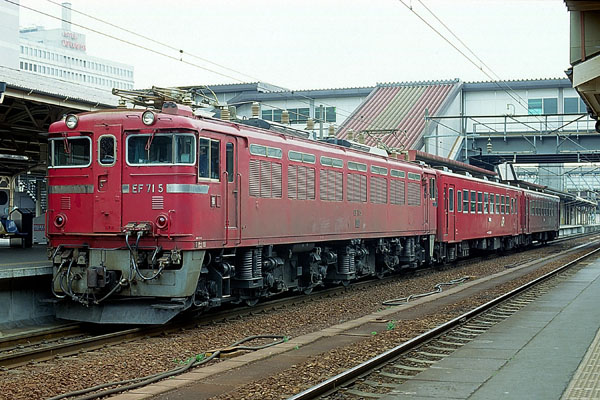
The special of this reskin collection.
The EF71 series locomotive was introduced in 1968 following the electrification in 20 000 V AC (50Hz) of the Ou Main Line between Yamagata and Yonezawa.
It was designed to haul heavy express passenger trains (and occasionally local ones) on the Itaya Pass, with a gradient of 33‰.
It was an en-longed variant of the ED75 Bo-Bo locomotive introduced in 1963, but with added a center bogie ( making it Bo-Bo-Bo ), a front cab door and other improvements for the harsh winter climate of northern Honshu.
In 1990, with the openin of the Yamagata shinkansen, classical express passenger trains were not needed anymore, so some EF71s were provisionally transferred to the Tohoku Main Line in 1991 and then retired definitely in 1993.
EF7 1 is stored at Rifu Shinaknsen Maintainance Center in Rifu (Miyagi Prefecture) along a few other historical locomotives previously used in the Tohoku area.
Trivia:
Following the opening of the Yamagata Shinkansen, the series 50 local passenger carriages of Akita depot (such as the ones in the image above) became surplus and were later converted into KiHa 141 series DMUs for JR Hokkaido in 1990.
[RC2-A/B/C] Euroliner Passenger coaches
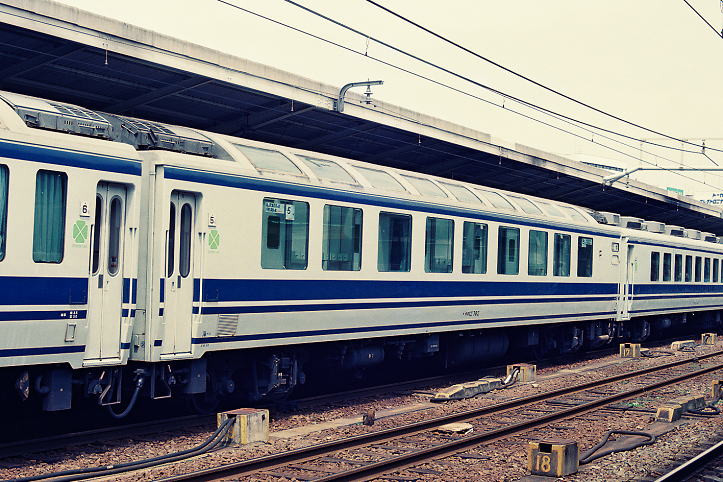
The Extra of this reskin collection.
Three coaches in euroliner colors, to be used with the EF64 35.
The "A" coach is the end car and it's based on the SuHaNeFu 14 series, the "B" coach is the standard seating car based on the OhaNe 14 series and the "C" coach is the panorama car based on the OhaNe 14-300 series.
Altough not entirely prototypical, these can be used as stand-ins until the corret coaches are realized.
Volume 2: The EF64
The pack contains 8 reskins of the EF64 by Hirochi, plus three reskinned 14-series passenger cars, also by Hirochi
https://drive.google.com/open?id=1H6LbNdybE9bqkazCh1b-HECNXAUAnlku
[RC2-1] EF64-1000 in JR Freight's revised refurbished livery (Okayama Depot).

In 2003, JR Freight started refurbishing and upgrading it's EF64-1000s.
They initially recieved the light blue-white livery identical to the refurbished EF64-0s, but due to complaints from the maintainance staff about visually distinguish them from refurbished EF65-1000s, a new livery based on blue and white with diagonal lines and a red JRF logo (dubbed the "milk carton" by railway enthusiasts) was introduced on the units of Takasaki Depot.
Okayama Depot instead applied a simplified livery based on the original JNR standard blue of non-refurbished units, with white lower cab fronts, logos and side line, retaining only the mustard-colored cab doors of the original refurbished livery.

A "milk carton" livery of Takasaki Depot units.
This variant has already been made by Hirochi as the EF64 1009 avaible on the DLS
[RC2-2] EF64-0 JR Freight Original Refurbished Livery (Omiya Works Variant)

Applied starting from 1996 on JR Freight EF64-0s, with EF64 67 being the first unit refurbished.
Used on freight duties on the Chuo Main line (Tokyo to Nagoya via Takao, Shiojiri and Nakatsugawa).
[RC2-3] EF64-0 JR Freight Original Refurbished Livery (Hiroshima Works Variant)

Like their eastern counterpart, the EF64-0s of Okayama depot started to recieve the refurbished livery in 1996, but with a few variants, such as a mostard-coloured front door and number plate.
They are in service on mountain routes in western Japan, such as the Hakubi line.
[RC2-4] EF64 1001 in brown livery with a white line

This locomotive is owned by JR East and based at Takasaki depot. It's employed primarily on passenger train charter duties, in October 2017 it was repainted into it's original JNR blue livery.
[RC2-5] EF64 37 Brown livery with silver numbers

Repainted into an all-brown livery in 2003 to commemorate the 100th anniversary of the opening of the Chuo Main Line between Kofu and Enzan.
Registered at Takasaki depot, but normally based at Kofu, it's used on passenger charter services and sometimes also on work and maintainance trains.
[RC2-6] EF64 41 Brown livery with golden numbers

Repainted in May 2006 to a brown livery based on the EF64 37, but with golden numbers insead.
Like the EF64 37, it's used on passenger charter services and sometimes also on work and maintainance trains.
[RC2-7] EF64 35 Euroliner - JR Central Joyful Train

The Euroliner was a Joyful train operated by JR Central from 1987 to 2005.
Originally planned in the very last years of JNR, it was composed of 14-series coaches in a variable composition between 5 and 10 cars.
It ran on the Chuo Main Line, the Tokaido Line and the (non electrified) Ida line.
A few locos were designated to haul this train, namely EF64 35 and 66, EF65 105, 106 and 112 and DD51 791 and 1037, all fitted in a matching livery.
The Euroliner was the first example of an expres train with all-uniform livery shared between the locomotive and the coaches.
It was withdrawn in 2005 following a decrease in ridership. The carriages were scrapped and the locomotives retuned to their original colors, except a few (such as the EF64 35) that carried the white and blue color well into the 2010s, usually assigned to work trains or charter specials.
[RC2-8] EF71 series AC electric locomotive

The special of this reskin collection.
The EF71 series locomotive was introduced in 1968 following the electrification in 20 000 V AC (50Hz) of the Ou Main Line between Yamagata and Yonezawa.
It was designed to haul heavy express passenger trains (and occasionally local ones) on the Itaya Pass, with a gradient of 33‰.
It was an en-longed variant of the ED75 Bo-Bo locomotive introduced in 1963, but with added a center bogie ( making it Bo-Bo-Bo ), a front cab door and other improvements for the harsh winter climate of northern Honshu.
In 1990, with the openin of the Yamagata shinkansen, classical express passenger trains were not needed anymore, so some EF71s were provisionally transferred to the Tohoku Main Line in 1991 and then retired definitely in 1993.
EF7 1 is stored at Rifu Shinaknsen Maintainance Center in Rifu (Miyagi Prefecture) along a few other historical locomotives previously used in the Tohoku area.
Trivia:
Following the opening of the Yamagata Shinkansen, the series 50 local passenger carriages of Akita depot (such as the ones in the image above) became surplus and were later converted into KiHa 141 series DMUs for JR Hokkaido in 1990.
[RC2-A/B/C] Euroliner Passenger coaches

The Extra of this reskin collection.
Three coaches in euroliner colors, to be used with the EF64 35.
The "A" coach is the end car and it's based on the SuHaNeFu 14 series, the "B" coach is the standard seating car based on the OhaNe 14 series and the "C" coach is the panorama car based on the OhaNe 14-300 series.
Altough not entirely prototypical, these can be used as stand-ins until the corret coaches are realized.
Last edited:

I will share for you that is a seibu 6000 Series that has been updated and there is only a slight deficiency in the sound of the engine is not like the original hope someone will help me to make the enginesound
link : https://drive.google.com/open?id=1Q2zOCDnu3lmJv0n_qWiOp-KFjgEMTS-B
Last edited:
Hi Guys.
I want to get started with a small Japanese route and have some questions which I hope you will take 2 minutes to reply on.
DLS
Apart from Keimei who has posted Japanese content on download station?
Rails/tracks
Which tracks do you prefer to use. I understand that ordinary Japanese trains use are of a special size??
Thank you very much
Morten
I want to get started with a small Japanese route and have some questions which I hope you will take 2 minutes to reply on.
DLS
Apart from Keimei who has posted Japanese content on download station?
Rails/tracks
Which tracks do you prefer to use. I understand that ordinary Japanese trains use are of a special size??
Thank you very much
Morten
Similar threads
- Replies
- 16
- Views
- 892
- Replies
- 3
- Views
- 488
- Replies
- 7
- Views
- 649
- Replies
- 22
- Views
- 961

